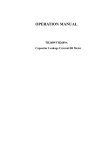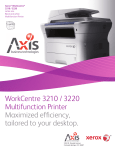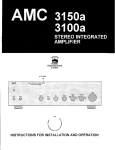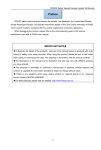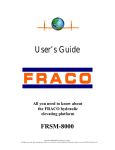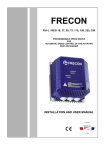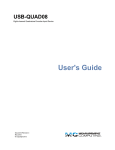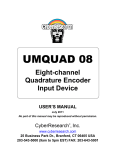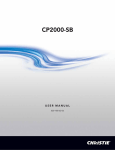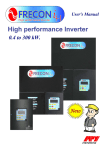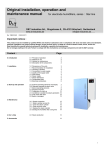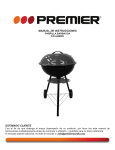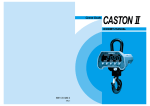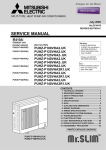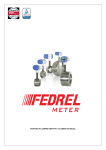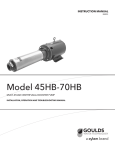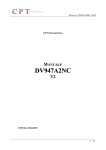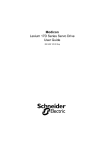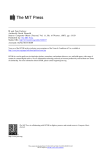Download - APY Engineering Co.,Ltd
Transcript
User's manual BLDC DRIVER (Type B) A.P.Y. ENGINEERING CO., LTD. 9/1 Moo 4, Soi Suksawat 62, Suksawat Rd., Kwang Bangmod, Khet Thoong-Kru Bangkok 10140 THAILAND TEL: +66 2818 2995 FAX: +66 2818 2996, 2818 2997 Web site: http://www.apyeng.com , E-mail: [email protected] MANUAL Version : E15 CONTENTS CONTENTS 1 2 3 4 5 6 7 8 9 10 11 12 13 LIST OF CHANGE…………........……………………………………………………………......... SAFETY INSTRUCTIONS………………............................................……………………......... INTRODUCTION……………..………………………………............………………………......... BLDC COMPRESSOR DRIVER SPECIFICATION…........................................…………......... THE FUNCTION BLOCK DIAGRAM OF FRECON COMPRESSOR DRIVER…........….......... INSTALLATION AND WIRING……………………………………………...........…………......... NON-PROGRAMMABLE PARAMETERS OF BLDC COMPRESSOR DRIVER……................. PROGRAMMABLE PARAMETERS OF BLDC COMPRESSOR DRIVER…….......……............ EXPLANATION OF NON-PROGRAMMABLE PARAMETERS……………............................... EXPLANATION OF PROGRAMMABLE PARAMETERS……………….................................... OPERATION MODE SELECTION………………………………………..............................…... RS485 MODBUS RTU COMMUNICATION……………………………..............................…... EXPLANATION OF DRIVER’S FAULT………………….............................................………… BL 1.9 Revision Date…19 Jul 2010… 1/35 2 3 7 11 12 14 20 20 21 24 25 27 34 1.1.LIST LISTOF OFCHANGE CHANGE Item Description 1. External operation : When analog command ≤ 1.05V., frequency command is 20Hz (F-00) for F003i-2SHB and F003i-2PHB External operation : When analog command ≤ 1.67V., frequency 2. command is 60Hz (F-00) for other model 3. External operation : Emergency Stop 4. Address #3 : Hold frequency (60.00~360.00Hz) = 60.00Hz 5. Address #4 : Hold frequency time (0.0~6000.0sec.) = 0.0sec 6. Ordering Information : Ordering Code of Driver (Compressor model, Maximum speed) 7. Standard Specifications : Add inverter type (F002i-2PHB, F008i-2PHB) 8. Revised ordering information : Table 1 Motor Specification (for BLDCM) 9. Revised standard specifications 10. Remark : The software trip level 11. Installation and Wiring : Installation Method 12. NON-PROGRAMMABLE PARAMETERS OF BLDC COMPRESSOR DRIVER : “F-00, F-01, F-07” 13. OPERATION MODE SELECTION : “External operation, Fig. 11-3 and Fig 11-4” 14. Trip Type Address 1416 : PFC Converter Fault, Heatsink temperature sensor error 15. Add “IPM or PFC module Temperature : Address 1420 (only F002i-2PHB, F003i-2PHB, F007i-2PHB and F008i-2PHB)” 16. Add “IPM or PFC module temperature limit protection flow chart” 17. Explanation of Driver's Fault : Fault code “OH-1, PFC, Err1” BL 1.9 Revision Date…19 Jul 2010… 2/35 Page Revision Date 25, 26 25 Dec.08 25, 26 25 Dec.08 25, 26 20, 24 20, 24 7 25 Dec.08 25 Dec.08 25 Dec.08 09 Dec. 09 11 8, 9 11 35 14 20 09 Dec. 09 01 Mar. 10 01 Mar. 10 01 Mar. 10 19 Jul. 10 19 Jul. 10 25, 26 19 Jul. 10 31 19 Jul. 10 32 19 Jul. 10 33 34 19 Jul. 10 19 Jul. 10 2.2.SAFETY SAFETYINSTRUCTION INSTRUCTION This instruction manual gives handling information and precautions for use of this inverter. Incorrect handling might cause an unexpected fault. Read this manual carefully before installing, connecting (wiring), operating, servicing, or inspecting the inverter. Familiarize yourself with all safety features before using this inverter. In this manual, safety messages are classified as follows: WARNING CAUTION Improper operation may result in serious personal injury or death. Improper operation may result in slight to medium personal injury or property damage. Note that the CAUTION level may lead to a serious consequence according to conditions. Please follow the instructions of both levels because they are important to personal safety. 2.1 Instructions on Use WARNING • This driver is designed to drive a brushless dc compressor and is not suitable for a single phase motor or others, as fire may result. • This driver may not be used as a component of a life-support system or other medical device directly affecting the personal welfare of the user. • Safety equipment must be installed or the failure of this device may result in personal injury, property damage, or if there is a risk of accident. 2.2 Instructions on Installation WARNING • Mount this driver on an incombustible material such as metal. Installing the inverter directly on or near a combustible or flammable material could lead to a fire. CAUTION • Do not hold or carry this driver by its cover, it may fall off. • Do not drop the driver, as injury may result. • Ensure that the driver and heat sink surfaces are kept free of foreign matter (lint, paper dust, small chips of wood or metal, and dust), as fire or accident may result. • Do not install or operate a damaged driver or an driver with missing parts, as electric shock or injury may occur. BL 1.9 Revision Date…19 Jul 2010… 3/35 2.3 Instructions on Wiring WARNING • Connect the driver to power via a line-protection molded-case circuit breaker or fuse, as fire may result. Always connect a ground wire, as electric shock or fire may result. • A licensed specialist must perform all wiring work, as electric shock may result. • Turn off the power before wiring, as electric shock may result. • Always install the driver before wiring, as electric shock or injury may occur. CAUTION • Confirm that the phases and rated voltage of this driver match those of the AC power supply, as injury may result. • Do not connect the output cables (U, V, W) to the AC power supply, as damage may result. • Do not fit capacitive equipment such as a power factor correction capacitor, noise filter or surge suppressor to the output of the driver. • The connection orientation of the output cables (U, V, W) to the compressor will affect the direction of rotation of the compressor. • Ensure that the noise generated by the driver, compressor, or wiring does not adversely affect peripheral sensors and equipment, as accident may result. 2.4 Instructions on Operation WARNING • Be sure to install the front cover before turning on the power. Do not run the driver with the front cover removed. Electric shock may occur. • Do not operate switches with wet hands, as electric shock may result. • Make sure that the start signal is off before resetting the inverter alarm. A failure to do so may restart the compressor suddenly. • Do not touch driver terminals when energized, even if the driver has stopped. Electric shock may result. BL 1.9 Revision Date…19 Jul 2010… 4/35 CAUTION • Do not start or stop the driver using the main circuit power. Failure may result. • Do not touch the heat sink because they become very hot. Burns may result. • The driver can be easily set for high-speed operation. Before changing its setting, examine the performance of the compressor and machine. Injury may result • The electronic over current protection does not guarantee protection of the compressor from overheating. • Before running the driver which had been stored for a long period, always perform inspection and test operation. 2.5 Instructions on Maintenance, Inspection and Replacement WARNING • Wait a minimum of 5 minutes after power has been turned off before starting inspection. Also confirm that the charge lamp is off and that DC voltage between terminals P and N does not exceed 25V Electrical shock may result. • Only authorized personal should perform maintenance, inspection, and replacement operation. Remove all metal jewelry such as watches and rings. Use insulated tools only. Electric shock or injury may result. CAUTION • Do not carry out a megger (insulation resistance) test on the control circuit of the driver. 2.6 Instructions on Disposal CAUTION • Treat as industrial waste when disposing of driver. 2.7 Other Instructions WARNING • Never modify the product. Electric shock or injury may result. BL 1.9 Revision Date…19 Jul 2010… 5/35 2.8 Conformity to Low Voltage Directive in Europe CAUTION • The ground terminal should be connected to ground. Use a crimp terminal to connect a cable to the main circuit terminal or driver ground terminal. • Use a single cable to connect the driver ground terminal. Do not use more driver ground terminals. • Use a molded-case circuit breaker (MCCB) and magnetic contactor (MC) that conform to EN or IEC standards. • Operate the driver under over-voltage Category III conditions and maintain pollution Degree 2 or better as specified in IEC664. To maintain Pollution Degree 2 or better, install the driver in a control panel structure (level NEMA 3 or higher) which is free from water, oil, carbon, dust etc. • To ensure safety, install an optional AC reactor, DC reactor as follows: 1) Install inside an IP4X cabinet or barrier if electrical parts are exposed. 2) Install inside an IP2X cabinet or barrier if electrical parts are not exposed. 2.9 General Instructions • For clarity, some figures in this manual may show the driver without covers for explanation purpose. Do not operate the device until all such covers have been replaced. The time required for the capacitors to discharge after the removal of power from the equipment. Capacitor discharge time: Min. 5 minutes BL 1.9 Revision Date…19 Jul 2010… 6/35 3.3.INTRODUCTION INTRODUCTION Thank you for choosing this FRECON BLDC compressor driver. This driver uses 32 bit CPU for multifunction in a variety of applications. 3.1 Driver inspection Please inspect the following points after unpacking your driver. If you have any problems or questions regarding the driver, please contact A.P.Y. Engineering Co., Ltd. or the distributor you purchased the unit from. 1) Check the nameplate on the driver cover to ensure that the specifications correspond to those you ordered. 2) Inspect visually if during shipping the unit have got any damage or disconnection on the parts or bent on cover on main unit panels. Ordering Information F 015 i - 4 T H 01 A A : Maximum Speed = 130 rps B : Maximum Speed = 120 rps C : Maximum Speed = 110 rps D : Maximum Speed = 95 rps E : Maximum Speed = 90 rps F : Maximum Speed = 80 rps G : Maximum Speed = 60 rps H : Maximum Speed = 100 rps Compressor Model (See table 1) A : For AC Induction compressor B : For DC Induction compressor H : H Series X : X Series FRECON Size of Inverter 2HP – 20HP IPM 2 : Power Supply 220V 4 : Power Supply 380V S : Input Supply Single phase (Diode Rectifier) T : Input Supply Three phase (Diode Rectifier) P : Input Supply Single phase (PFC Converter) Fig. 2-1 BL 1.9 Revision Date…19 Jul 2010… B 7/35 BL 1.9 Revision Date…19 Jul 2010… 8/35 BL 1.9 Revision Date…19 Jul 2010… 9/35 3.2 Product warranty This product is guaranteed against defects in workmanship for 12 months from the purchasing date. However, the troubles caused by the following reasons are not covered by this warranty even in warranty period. 1) Problems caused by incorrect operation or by unauthorized repairs or modifications. 2) Problems resulting from using the driver in the range outside the standard specification. 3) Damage to the driver after purchase or during delivery. 4) Damage caused by earthquakes, fire, floods, lightning, abnormal voltage fluctuations or other natural disasters and secondary disasters. 5) Damage caused by water. 6) Damage caused by animal or insect. 7) The external case or parts are damaged. 8) Damage caused by intention, accident or carelessness BL 1.9 Revision Date…19 Jul 2010… 10/35 BLDC COMPRESSOR DRIVER SPECIFICATION 4.4.BLDC BLDCCOMPRESS COMPRESSDRIVER DRIVERSPECIFICATION SPECIFICATION Inverter type Inverter Control method Power Supply Converter Inverter Method Voltage Frequency Environment Agency Certification 220V series F007i-2PHB F008i-2PHB 1 ∅ PFC 1 ∅ PFC MAX.30 Arms MAX.36Arms Size (mm.) (WxHxD) Weight (kg.) Cooling Ambient Temperature Storage Temperature Vibration F008i-2SHB F010i-2SHB 1 ∅ Diode Rectifier F010i-2THB 3 ∅ Diode Rectifier F005i-4THB F008i-4THB 1 ∅ 200 - 240 V~ 380V series F010i-4THB F015i-4THB F020i-4THB 25 Arms 34 Arms 3 ∅ Diode Rectifier 3 ∅ IPM Inverter Sensorless Vector Control Method 3 ∅ 200 - 240 V~ 50/60 Hz Tolerance Operating Revolution PWM Control Carrier Frequency Output Current Protection Method Communication Baud rate Format Structure F002i-2PHB F003i-2PHB F005i-2SHB 1 ∅ PFC 1 ∅ Diode 1 ∅ PFC MAX.16 Arms MAX.20 Arms Rectifier 3 ∅ 360 - 460 V~ Voltage +10/-15% , Frequency ± 5% 10 - 130 rps (depend on motor specification ; see table 1) 9 Arms 13 Arms 4 kHz 17 Arms 22 Arms 25 Arms 25 Arms 34 Arms 34 Arms 10 Arms 14 Arms 18 Arms Fin over heat, Over current, Under/over voltage, Overload, Compressor connection loss, Communication loss, PFC converter fault Asynchronous Half Duplex 1200 bps 8-N-1 (8 data bits, none parity bit, 1 stop bit) 314x165x170 314x165x170 372x215x150 372x215x150 372x215x150 372x215x150 372x225x190 5.3 5.3 11 12 11 372x215x150 Under developed Under developed - - 12 16 12 AL Fin Mounting and Forces Air Cooling -20 to +70°C, 30 to 80% RH (Don’t condense, don’t freeze) -20 to +80°C, 25 to 85% RH (Don’t condense, don’t freeze) Max. 5.9 m/s2 (0.6g), 10 to 55 Hz The drive is designed to meet applicable requirements of the following codes/standards: EN61800-5-1 Adjustable speed electrical power drive systems - P.5-1: Safety requirements-electrical, thermal and energy Marked for all applicable European Directives EMC Directive (89/336/EEC) Emissions: EN 61800-3 Adjustable Speed electrical power drive systems Part 3 Immunity: EN 61800-3 Second Environment, Restricted Distribution Low Voltage Directive (73/23/EEC) BL 1.9 Revision Date…19 Jul 2010… 11/35 334x215x150 334x215x150 372x215x150 11.5 11.5 13 5.5.THE THE FUNCTION FUNCTIONBLOCK BLOCKDIAGRAM DIAGRAMOF OFFRECON FRECONCOMPRESSOR COMPRESSORDRIVER DRIVER Fig.5-1 Fig. 5-2 BL 1.9 Revision Date…19 Jul 2010… 12/35 Fig. 5-3 Fig. 5-4 BL 1.9 Revision Date…19 Jul 2010… 13/35 6.6.INSTALLATION INSTALLATIONAND ANDWIRING WIRING 6.1 Operating Environment Install this driver in location that meets the conditions as follow. Item Specifications Location Inside the cabinet (a well-ventilated room) Ambient Temperature -20°C to +70°C (-4°F to +158°F) Relative Humidity 30 to 80 % (Don’t condense, don’t freeze) The driver must not be exposed to dust, direct sunlight, corrosive gas, explosive gas, inflammable gas, oil mist, vapor, or water. There must be minimum salt content in the Atmosphere atmosphere. Do not store where condensation may occur as a result of sudden changes in temperature 1000 m (3300 feet) or lower. After that derate by 3% for every extra 500 m up to 3000 m Altitude (88%) Vibration Max. 5.9 m/s2 (0.6g), 10 to 55Hz 6.2 Installation Method • Install the driver securely with screws or bolts in the vertical direction. Do not turn the driver upside down or install in a horizontal position. The cooling air should flow through heat sink, reactor and box of driver to extend lifetime of driver. (see Fig. 6-1 (b)) • Since heat is generated during drive operation, the spaces shown in Fig. 6-1 (a) are required to ensure sufficient cooling. Do not install the driver beneath a device sensitive to heat as heat radiates upward. • The heat sink and reactor may reach a temperature of 90°C and 125°C during driver operation. Ensure that the material surrounding the product can withstand this temperature. • Consider ventilation inside the cabinet to prevent the drive’s ambient temperature from exceeding the specified value. Do not install the product in an area from which heat can not be sufficiently released. • If two or more driver must be installed in the same cabinet, arrange the units horizontally to minimize the effect of heat. If two or more driver must be installed vertically, place an insulated plate between the driver to minimize the effect of heat. BL 1.9 Revision Date…19 Jul 2010… 14/35 (a) (b) Fig. 6-1 6.3 Wiring Method 6.3.1 Wiring of the main circuit 1) Crimping terminals with insulation sleeves are recommended for use with the power and compressor cables. 2) Check that the power supply voltage is within the maximum allowable voltage marked on the nameplate of the driver. Connect the AC power input cables (R, S, T, or L, N) to the power supply via a mold-case circuit breaker for circuit protection. 3) Check that the voltage, current and power of compressor are within the maximum allowable capacity marked on the nameplate of the driver. Connect the driver output cables (U, V, W) to a 3-phase compressor in correct phase sequence. 4) Power supply must not be applied to the output cables (U, V, W) of the driver. Otherwise the driver will be damaged. 5) After wiring, wire off-cuts must not be left in the driver. Wire off-cuts can cause a fault, failure or malfunction. Always keep the driver clean. When drilling mounting holes in a control box etc., exercise care to prevent chips and other foreign matter from entering the driver. 6) Use cables of the recommended size for wiring to make the voltage drop 2 % or less. If the wiring distance is long between the driver and compressor, a cable voltage drop will cause the motor torque to decrease especially at the output of low frequency. 7) Do not install a power factor correction capacitor or surge absorber in the output side of the driver. 8) Do not connect a magnetic starter or magnetic contactor to the output side of the driver. If the load is connected while the driver is running, the driver over current protective circuit operates because of inrush current. BL 1.9 Revision Date…19 Jul 2010… 15/35 9) The driver should not be operated/stopped by opening/closing the magnetic contactor at the input side of the driver. Frequent switching may cause the driver to malfunction. 10) When rewiring after operation, make sure that the power lamp has gone off, and when more than 10 minutes have elapsed after power-off, check with a tester that the voltage is zero. After that, start rewiring work. 11) AC reactor should be connected under the following condition. • The capacity of the power supply transformer exceeds 500kVA and exceeds the rated capacity of the drive tenfold. (See Fig. 6-2) • Used to prevent the driver over voltage trip from occurring when the power factor capacitor in the power line is switched on and off. • When the voltage imbalance exceeds 3 % Imbalance rate between phase [%] = (Max. voltage [V] – Min voltage [V]/3 phase average voltage [V] Fig. 6-2 12) Do not run the power cables (input and output of the driver) and signal cables of the driver in parallel with each other and do not bundle them. 13) If the cable from the in driver to the compressor is very long, a high-frequency current may be generated by stray capacitance between the cables and result in an over current trip of the driver, an increase in leakage current, or a reduction in current indication precision. BL 1.9 Revision Date…19 Jul 2010… 16/35 6.3.2 Grounding instructions 1) Leakage currents flow in the driver. To prevent an electric shock, the driver and compressor must be grounded (220V class …class 3 grounding, grounding resistance 100Ω maximum), (380V class … special class 3 grounding, grounding resistance 10Ω or less). 2) Use the dedicated ground cable (E) to ground the driver. 3) When using several driver units side by side, ground the units as shown in (a) or (b) of Fig. 6-3. Do not loop the ground wires as shown in (c). INV.1 INV.2 INV.3 INV.1 INV.2 INV.3 INV.1 INV.2 INV.3 (a) (b) (c) Fig. 6-3 6.3.3 Wiring of the control circuit 1) Separate control circuit wires from main circuit wires and other power cables to prevent erroneous operation caused by noise interference. 2) Use twisted shield or twisted-pair shielded wire for the control circuit line and connect the shielded sheath to the ground. 3) A wiring distance should be less than 20 m. BL 1.9 Revision Date…19 Jul 2010… 17/35 6.3.4 Wiring Diagram Fig. 6-4 6.3.5 Power Cables Connection Cable Description R (L) S Connect to the commercial power supply T (N) U V Connect to BLDC compressor W (E) Connect the driver chassis (case) to earth BL 1.9 Revision Date…19 Jul 2010… 18/35 6.3.6 Control terminal connection Terminal RUN 0-10V +12 OP1 CM Tx/RxTx/Rx+ Description Turn on to start compressor in external operation mode. Analog input for frequency command in external operation mode. DC power supply 12V 100mA Fault signal output (Open Collector) Control signal ground Transmit/Receive – signal of RS485 communication Transmit/Receive + signal of RS485 communication 6.3.7 Terminal Layout Interface with APY Outdoor Control Board External Run Fault Output (Open Collector 100mA max) Frequency Command 0-10Vdc RS485 MODBUS RTU Communication Pin4/5 = TxRx-/TxRx+ 8 Connect Jumper: external Run & 0-10V Command Remove Jumper: Modbus operation (Address 1408-1409) 1 Earth Fig. 6-5 BL 1.9 Revision Date…19 Jul 2010… 19/35 7.7.NON NON--PROGRAMMABLE PROGRAMMABLEPARAMETERS PARAMETERSOF OFBLDC BLDCCOMPRESSOR COMPRESSORDRIVER DRIVER CODE F-00 F-01 F-02 F-03 F-04 F-05 F-06 F-07 F-08 F-09 F-10 F-11 F-12 F-13 F-14 F-15 F-16 F-17 F-18 PARAMETER DATA For Compressor 4 Pole For Compressor 6 Pole 30.00Hz or 60.00Hz Minimum frequency 20.00Hz (depend on compressor model) Maximum frequency Depend on Compressor model Acceleration time 1 (start interval) 12.5 sec. (2 rps/sec.) 8.3 sec. (2 rps/sec.) Acceleration time 2 (normal operation) 12.5 sec. (2 rps/sec.) 8.3 sec. (2 rps/sec.) Deceleration time 1 (normal operation) 12.5 sec. (2 rps/sec.) 8.3 sec. (2 rps/sec.) Deceleration time 2 (deceleration to stop) 12.5 sec. (2 rps/sec.) 8.3 sec. (2 rps/sec.) Start frequency 0.50Hz 0.50Hz 30.00Hz or 60.00Hz Stop frequency 20.00Hz (depend on compressor model) Thermal overload level 100 % of rated current 100 % of rated current Current limit with frequency level 100 % of rated current 100 % of rated current Band of current limit 4 % of rated current 4 % of rated current Deceleration time when current limit active 12.5 sec. (2 rps/sec.) 8.3 sec. (2 rps/sec.) Node address for MODBUS 1 1 Baud rate 1200 bits/sec. 1200 bits/sec. Data format 8-N-1 8-N-1 Reply interval 10 ms. 10 ms. Communication loss time out 5 sec. 5 sec. Time out action for MODBUS Deceleration to stop Deceleration to stop Switching frequency 4kHz 4kHz Note : • User can see compressor model in Table 1 • User can not change the above parameter by keypad or MODBUS communication • If user want to change it, please contact A.P.Y.ENGINEERING Co., Ltd. 8.8.PROGRAMMABLE PROGRAMMABLEPARAMETERS PARAMETERSOF OFBLDC BLDCCOMPRESSOR COMPRESSORDRIVER DRIVER CODE P-03 P-04 PARAMETER Hold frequency (Address #3) Hold frequency time (Address #4) DATA 60.00 ~ 360.00Hz. 0.0 ~ 6000.0 sec. DEFAULT 60.00 0.0 Note: User can change the above parameter by MODBUS communication. (Address #3 and address #4) BL 1.9 Revision Date…19 Jul 2010… 20/35 9.9.EXPLANATION EXPLANATIONOF OFNON NONPROGRAMMABLE PROGRAMMABLEPARAMETERS PARAMETERS F-00: Minimum frequency F-01: Maximum frequency Output frequency of compressor driver can be limited by minimum frequency and maximum frequency (F-00 and F-01). Frequency command via RS485 : If frequency command < F-00, output frequency = 0 (stop) Frequency command via analog command (0-10 Vdc) : If frequency command < F-00, output frequency = F-00 Fig. 9-1 F-02: F-03: F-04: F-05: F-06: F-07: Acceleration time 1 (start interval) Acceleration time 2 (normal operation) Deceleration time 1 (normal operation) Deceleration time 2 (deceleration to stop) Start frequency Stop frequency Acceleration time = A time to accelerate frequency from 0.00Hz to 50.00Hz (reference frequency). Deceleration time = A time to decelerate frequency from 50.00Hz (reference frequency) to 0.00Hz Example User want to increase frequency from 0.00Hz to 100.00Hz within 5 sec, the acceleration time must be set = 2.5 sec. or user want to decrease frequency from 100.00Hz to 0.00Hz within 10 sec, the deceleration time must be set = 5 sec. Fig. 9-2 BL 1.9 Revision Date…19 Jul 2010… 21/35 The start frequency of compressor is 0.5Hz (F-06).The frequency increase from 0.5Hz to 15Hz within 1.45 sec. After that it increases from 15Hz to hold frequency (P-03 = 60.00Hz) by acceleration time1 (F-02) and remains stable for hold frequency time (P-04 = 0.0 sec.) before reaching to the target frequency by acceleration time2 (F-03). When the target frequency is decreased, the frequency will be decreased by deceleration time1 (F-04.). When the compressor is stopped, frequency will be decreased to stop frequency (F-07) by deceleration time2 (F05). After that the compressor is free run. Refer to the diagram below. Fig. 9-3 F-08: Thermal overload level The electronic thermal overload protection in the inverter detects motor overheat due to overload. If the thermal overload level (F-08) is 100% of rated current, when a current more than 100% of rated output current flows, inverse-time characteristic cause the electronic thermal overload protection to be activated to stop the inverter output. (overload immunity: 150% of rated current in 1 minute) Fig. 9-4 BL 1.9 Revision Date…19 Jul 2010… 22/35 F-09: Current limit with frequency level F-10: Band of current limit F-11: Deceleration time when current limit active Current limit with frequency protection will be activated when compressor current more than rated current (F-09 = 100% of rated current.). The protected operation and condition to stop protection can be shown as following. Irate = Rate current I = Compressor current Imin = [(100 - band in F-10) x Irated] / 100 Freq. = Operating frequency Freq.com = Frequency command Fig. 9-5 BL 1.9 Revision Date…19 Jul 2010… 23/35 F-12: Node address for MODBUS The address of inverter for MODBUS communication. (See more detail in communication Protocol) F-13: Baud rate Baud rate is the rate of transmission or receiving data. (See more detail in communication Protocol) F-14: Data format Data format is the format in a frame of transmission / receiving data. The format 8-N-1 can be shown as following. 8 = 8 bits data length N = none parity bit 1 = 1 stop bit (See more detail in communication Protocol) F-15: Reply interval When the inverter receives data command from communication, there is some delay time before the reply of inverter. This delay time is reply interval. F-16: Communication loss time out It is the time that the inverter will remain in communication loss before implementing the action in F-17. F-17: Time out action for MODBUS It is the inverter’s response to a loss of the communication connection or excessive communication errors. F-18: Switching frequency User can adjust motor noise by changing the switching frequency. A reduced switching frequency will decrease leakage current but increase motor noise. 10. 10.EXPLANATION EXPLANATIONOF OFPROGRAMMABLE PROGRAMMABLEPARAMETERS PARAMETERS P-03: Hold frequency P-04: Hold frequency time Start up frequency of compressor is 0.5Hz The frequency increase from 0.5Hz To “hold frequency” (P-03) And remains stable for “hold frequency time” (P-04). After that the frequency will accelerate to the target with 2 rps/sec. Fig. 10-1 BL 1.9 Revision Date…19 Jul 2010… 24/35 11. 11.OPERATION OPERATIONMODE MODESELECTION SELECTION 11.1 RS485 operation with MODBUS RTU: Remove Jumper “MD” on main board (see wiring diagram) The FRECON driver has ability to communicate with the MODBUS RTU protocol via the RS485 communication link, which is one of the favorite industrial communications. In this mode, the driver receives frequency and control command from outdoor controller in order to drive the BLDC compressor. (See detail in Communication Protocol) Fig. 11-1 11.2 External operation: Connect Jumper “MD” on main board (see wiring diagram) In this mode, the driver has 2 inputs and 1 output connector to command compressor. The frequency command (0.00~maximum frequency) receives from analog command (0-10Vdc) see Fig. 11-3. The compressor can be run by closing the external run switch and stop compressor or reset fault by opening this switch. When the analog command (0-10Vdc) is less than minimum frequency (0.91V or 1.67V or etc depend on compressor model) and the external run switch is opened, the frequency will be decreased to zero immediately (emergency stop) see Fig. 11-4. The outdoor controller can receive fault signal from OP1 connector. (See detail in Wiring Diagram of BLDC driver) Fig. 11-2 BL 1.9 Revision Date…19 Jul 2010… 25/35 When analog command ≤ 0.91V, Frequency command is 20Hz (F-00) (a) Example for compressor model TNB220FLHMT Minimum frequency = 20Hz Maximum frequency = 220Hz Fig. 11-3 [The external run switch is opened and analog command is less than minimum frequency (0.91V or 1.67V or etc depend on compressor mode)] Fig. 11-4 BL 1.9 Revision Date…19 Jul 2010… 26/35 When analog command ≤ 1.67V, Frequency command is 60Hz (F-00) (b) Example for compressor model ANB42FBEMT Minimum frequency = 60Hz Maximum frequency = 360Hz 12. 12.RS485 RS485MODBUS MODBUSRTU RTUCOMMUNICATION COMMUNICATION (See more information in www. Modbus.org 12.1 Interface Circuit Outdoor controller side Driver side VCC 2K TLP 521 RXD +5 From MCU VCC 1K 10 +5 2K2 SN75176 2K VCC TLP 521 1 2 3 4 1K TXD R RE DE D RS485 103 +5 VCC B A GND 1 1 3 3 5 5 2 8 7 6 5 TX/RX- 4 TX/RX+ 6 +5M 7 2K2 10 SN75176 VCC 4 TX/RX- 6 TX/RX+ 8 7 6 5 7 +5M VCC B A GND R RE DE D 1 2 3 4 RXD Dir TXD 8 Mod BUS +5 103 2 8 From MCU 10 RS485 Mod BUS 2K2 2K2 103 VCC 10 TLP 521 10 103 103 1K Dir From MCU Fig. 12-1 The communication system must be wiring be wiring by the 2-line cable. It’s recommended to use the shield cable for noise reduction and may connect the termination resister, which has the value matching to the cable (normally 120Ω), at the beginning and the end of the communication line if necessary (the communication link in quite long) 12.2 Transmission Type Items Method Baud Rate Data Bit Length Parity Bit Stop Bit Length 12.3 Data Format 8–N–1 ST D0 D1 ST : Start Bit D0~D7 : Data Bit SP : Stop Bit BL 1.9 Revision Date…19 Jul 2010… Content Asynchronous Half Duplex 1200 bps 8 bit None 1 bit D2 D3 D4 D5 Fig. 12-2 27/35 D6 D7 SP 12.4 MODBUS RTU Protocol • Master / Slave communication • Master: Communication Starter (Outdoor controller) • Slave: Receive and Response to Master (Driver) 12.4.1 Transmission Frame START ADDRESS FUNCTION DATA T1 – T2 – T3 – T4 8 BITS 8 BITS N x 8 BITS T1-T2-T3-T4: Wait time = 3.5 of 1 bytes transmission ERROR CHECK 16 BITS END T1 – T2 – T3 – T4 12.4.2 Data in MODBUS Frame 1) ADDRESS: Address of slave 1–247 2) FUNCTION: Read or write function 3) DATA: Data that correspond to read or write function 4) ERROR CHECK: Data for checking the communication error 12.4.3 FUNCTION in MODBUS Frame 1) Read Holding Registers (Code = 03): Read data of 16 bit register from slave. This function can read maximum 255 registers in the continuous address at one time. In the FRECON driver, the maximum 18 register can be read (when reading Register 1408-1425) Master (Query) Slave Address Function (3) Start Address (Hi) Start Address (Lo) No. of Register (Hi) No. of Register (Lo) Error Check Slave (Response) Slave Address Function (3) Data Byte Count Data 1 (Hi) Data 1 (Lo) Data 2 (Hi) Data 2 (Lo) Data N (Hi) Data N (Lo) Error Check Fig. 12-3 BL 1.9 Revision Date…19 Jul 2010… 28/35 2) Preset Single Register (Code = 06): Write single data to 16 bit register of slave. Master (Query) Slave Address Function (6) Register Address (Hi) Register Address (Lo) Preset Data (Hi) Preset Data (Lo) Error Check Slave (Response) Slave Address Function (6) Register Address (Hi) Register Address (Lo) Preset Data (Hi) Preset Data (Lo) Error Check Fig. 12-4 3) Preset Multiple Register (Code = 16): Write multiple data to 16 bit registers of slave. This function can write maximum 8 register in the continuous address at one time. Master (Query) Slave Address Function (16) Start Address (Hi) Start Address (Lo) No. of Register (Hi) No. of Register (Lo) Data Byte Count Preset Data 1 (Hi) Preset Data 1 (Lo) Preset Data 2 (Hi) Preset Data 2 (Lo) Slave (Response) Slave Address Function (16) Start Address(Hi) Start Address(Lo) No. of Register (Hi) No. of Register (Lo) Error Check Preset Data N (Hi) Preset Data N (Lo) Error Check Fig. 12-5 BL 1.9 Revision Date…19 Jul 2010… 29/35 12.4.4 Read / Write Register List 1) Frequency command: Address 1408 (User can write this register when jumper “MD” on main board has been removed; see operation mode selection) 0 – 36000: 0.00 – 360.00Hz 2) Control Command: Address 1409 (User can write this register when jumper “MD” on main board has been removed; see operation mode selection) Bit 0: Run / Stop compressor 0 = Stop, 1= RUN Bit 1: Emergency stop 0 = Disable, 1 = Enable Bit 2: Reset fault 0 = Disable, 1 = Enable Bit 3 – 15: Reserve Fig. 12-6 3) Reserve : Address 1410 – 1414 12.4.5 Read Only Register List 1) Outdoor unit Status: Address 1415 Bit 0: Stop / Run mode 0 = Stop mode, 1 = Run mode Bit 1: Normal / Trip mode 0 = Normal mode, 1 = Trip mode Bit 2: Steady state 0 = Not steady state, 1 = Steady state Bit 3: Acceleration state 0 = Not Acceleration state, 1 = Acceleration state Bit 4: Deceleration state 0 = Not Deceleration state, 1 = Deceleration state Bit 5 – 11: Reserve Bit 12: Compressor oil return state 0 = Not complete, 1 = Complete Bit 13: Compressor speed decelerate by protection 0 = Not active, 1 = Active Bit 14: Compressor is not connected warning 0 = Normal, 1 = Warning Bit 15: Reserve BL 1.9 Revision Date…19 Jul 2010… 30/35 “NC Warning Flow chart” Fig. 12-7 2) Trip Type: Address 1416 Value = 0: Not trip Value = 1: Heatsink over heat Value = 2: Over current at acceleration state (Hardware trip) Value = 3: Over current at steady state (Hardware trip) Value = 4: Over current at deceleration state (Hardware trip) Value = 5: DC Bus under voltage Value = 6: DC Bus over voltage Value = 7-8: Reserve Value = 9: PFC Converter Fault (only F002i-2PHB, F003i-2PHB, F007i-2PHB and F008i-2PHB) Value = 10: Over current at acceleration state (Software trip) Value = 11: Over load fault Value = 12: Over current at steady state (Software trip) Value = 13: Over current at deceleration state (Software trip) Value = 14: Reserve Value = 15: Communication loss time out Value = 16: Heatsink temperature sensor error (only F002i-2PHB, F003i-2PHB, F007i-2PHB and F008i-2PHB) Value = 17-19: Reserve Value = 20: Abnormal condition BL 1.9 Revision Date…19 Jul 2010… 31/35 3) Operating Frequency of compressor: Address 1417 0 ~ 36000: 0.00 – 360.00Hz 4) IPM or PFC module Temperature: Address 1420 (only F002i-2PHB, F003i-2PHB, F007i-2PHB and F008i-2PHB) -200 ~ 1800: -20.0 ~ 180.0°C 5) Compressor Current: Address 1422 0 ~ 450: 0.0 ~ 45.0 Arms 6) Output voltage: Address 1423 0 ~ 400: 0 ~ 400 Vrms 7) DC Bus voltage: Address 1424 0 ~ 800: 0 ~ 800V 8) Estimated speed: Address 1425 0 ~ 36000: 0 ~ 360.00Hz Fig. 12-8 BL 1.9 Revision Date…19 Jul 2010… 32/35 IPM or PFC module temperature limit protection flow chart (only F002i-2PHB, F003i-2PHB, F007i-2PHB and F008i-2PHB) T = IPM or PFC module Temperature (address 1420) Freq. = Operating frequency Freq.com= Frequency command Fig. 12-9 BL 1.9 Revision Date…19 Jul 2010… 33/35 13. 13.EXPLANATION EXPLANATIONOF OFDRIVER'S DRIVER'SFAULT FAULT Address #1416 1 2 3 4 5 6 7-8 9 10 11 12 13 14 15 16 Fault code OH-1 Description Corrective action IPM module over heat (100 ~ 125°C ) PFC module over heat ( > 95°C ) OC-A Over current or output short circuit during Speed acceleration (hardware trip) OC-C Over current or output short circuit during Speed steady state (hardware trip) OC-d Over current or output short circuit during Speed deceleration (hardware trip) -LU- DC bus under voltage 220V series: 175Vdc 380V series: 310Vdc -OU- DC bus over voltage 220V series: 400Vdc 380V series: 800Vdc Reserve PFC PFC Converter fault (only F002i-2PHB, F003i-2PHB, F007i-2PHB and F008i-2PHB) 1. Check cooling fan 2. Check ambient temperature 1. Check motor coil resistance 2. Check motor insulation 1. Check the same as OC-A 1. Check the same as OC-A 1. Check input voltage level 2. Check power source and wiring 3. Check pre-charge contactor 1. Check input voltage level 2. Check power source and wiring 1. Check reactor inductance 2. Check reactor insulation 3. Check bus voltage capacitor 1. Check the same as OC-A oc_A Over current or output short circuit during Speed acceleration (Software trip) -OL- Output current exceeded the electronic thermal overload level for a long time (150% of rated in 60 sec.) oc_C Over current or output short circuit during Speed steady state (software trip) oc_d Over current or output short circuit during Speed deceleration (software trip) Reserve -tOModbus communication loss time out Err 1 1. Reduce the load compressor 2. Increase the capacity of driver appropriately 1. Check the same as OC-A 1. Check the same as OC-A Heat sink temperature sensor error (only F002i-2PHB, F003i-2PHB, F007i-2PHB and F008i-2PHB) BL 1.9 Revision Date…19 Jul 2010… 34/35 1. Check signal of TxRx+/TxRx- (Pin4/5 of Modbus connector) 2. Check communication signal of outdoor controller 1. Check heat sink temperature sensor wiring Address Fault Description #1416 code 17-19 Reserve 20 AbnC Abnormal condition (frequency decelerate to stop by current limit protection or heatsink temperature protection Corrective action 1. Check cooling fan 2. Check air–condition system Remark: • OC-A, OC-C and OC-d are hardware trip. The trip level depends on IPM power module. • oc_A, oc_c and oc_d are software trip. The trip level are as following. F005i-4THB (10 Arms. 380V): 25 Apeak. instantaneously. F008i-4THB (14 Arms. 380V): 35 Apeak. instantaneously. F010i-4THB (18 Arms. 380V): 50 Apeak. instantaneously. F015i-4THB (25 Arms. 380V): 50 Apeak. instantaneously. F020i-4THB (34 Arms. 380V): 75 Apeak. instantaneously. F002i-2PHB (9 Arms. 220V): 20 Apeak. instantaneously. F003i-2PHB (13 Arms. 220V): 30 Apeak. instantaneously. F007i-2PHB (22 Arms. 220V): 50 Apeak. instantaneously. F008i-2SHB (25 Arms. 220V): 50 Apeak. instantaneously. F008i-2PHB (25 Arms. 220V): 50 Apeak. instantaneously. F010i-2SHB (34 Arms. 220V): 75 Apeak. instantaneously. F010i-2THB (34 Arms. 220V): 75 Apeak. Instantaneously • The difference between over current (OC-A,OC-C,OC-d,oc_A,oc_c and oc_d) and overload (-OL-) is : Over current is the instantaneous trip. : Overload is not instantaneous trip. (Please see detail in manual page 22/35 ; F-08) • LED indicator on main board shows as following Stop mode: (slow blink) ON 1 sec. OFF 0.5 sec. Trip mode: (Fast blink) ON 0.2 sec. OFF 0.2 sec. Run mode: ON all time. BL 1.9 Revision Date…19 Jul 2010… 35/35





































